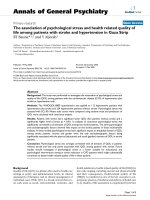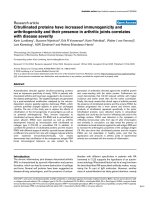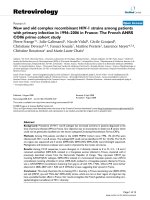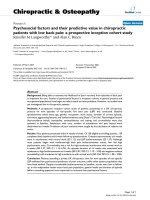Bacterial isolates and their antibiotic susceptibility pattern among patients with pus and/or wound discharge at Gouri Devi institute of medical sciences and hospital
Bạn đang xem bản rút gọn của tài liệu. Xem và tải ngay bản đầy đủ của tài liệu tại đây (188.33 KB, 7 trang )
Int.J.Curr.Microbiol.App.Sci (2019) 8(5): 2468-2474
International Journal of Current Microbiology and Applied Sciences
ISSN: 2319-7706 Volume 8 Number 05 (2019)
Journal homepage:
Original Research Article
/>
Bacterial Isolates and their Antibiotic Susceptibility Pattern among
Patients with Pus and/or Wound discharge at Gouri Devi Institute of
Medical Sciences and Hospital
R. Priscilla* and Arun Ghosh
Department of Microbiology, Gouri Devi Institute of Medical Sciences and Hospital,
Durgapur, West Bengal, India
*Corresponding author
ABSTRACT
Keywords
Pus, Wound
discharge, Surgical
site infection (SSI)
and Pseudomonas
aeruginosa
Article Info
Accepted:
26 April 2019
Available Online:
10 May 2019
In spite of advances in control of infections, wound infections have not completely
controlled due to many reasons. The widespread uses of antibiotics, together with the
length of time over which they have been available have led to major problems of resistant
organisms contributing to morbidity and mortality. This study was aimed to assess
bacterial isolates and their drug susceptibility patterns from patients with pus and/or
wound discharge. A retrospective study was conducted at Gouri Devi Institute of Medical
Sciences and hospital from all individuals who provide pus and/or wound discharge
samples from June 2017 to May 2018. The records of wound swab samples obtained from
patients with different kinds of wounds, receiving treatment at the Gouri Devi Institute of
Medical Sciences and Hospital, Durgapur, West Bengal, were analysed by using a standard
data collection format. Data were analyzed using SPSS version 11 software. P-value ≤ 0.05
was considered statistically significant. A total of 104 samples were included in the study
with bacterial isolation rate of 87 with the isolation rate of (83.65%). Of all, 56 (53.84%)
were females, 75 (86.20%) of the isolates were gram negative and 12 (13.79%) were gram
positive. About 39/87 (44.82%) of the total isolates were Pseudomonas aeruginosa,
Coagulase positive Staphylococci (13.79%), Coliform (except E. coli) (13.79%), Proteus
mirabilis (11.49%), Klebsiella pneumoniae (9.19%) and Escherichia coli (6.89%). The
result showed that 66.2% of the isolates were resistant to tetracycline, followed 59.8% for
ampicillin, 59.1% for cotrimoxazole, 51.7% for Erythromycin, least resistant being 6.3%
for gentamycin. High prevalence of bacterial isolates were found; Pseudomonas
aeruginosa being the dominant. Most of the isolates were resistant to many of the
antibiotics tested where all isolates of Staphylococcus aureus being resistant to two or
more antibiotics. Antibiotic susceptibility test is necessary for effective control of wound
infections.
Introduction
A wound is a breakdown in the protective
function of the skin; the loss of continuity of
epithelium, with or without loss of underlying
connective tissue1. Wounds can be accidental,
pathological or post-operative. An infection
of this breach in continuity constitutes wound
2468
Int.J.Curr.Microbiol.App.Sci (2019) 8(5): 2468-2474
infection. Wound infection is thus the
presence of pus in a lesion as well as the
general or local features of sepsis such as
pyrexia, pain and induration. Infectious
diseases still remain an important cause of
morbidity and mortality among humans,
especially in developing countries. Various
species of bacteria live on human skin,
gastrointestinal tract, in the nasopharynx and
other parts of the body with less potential for
causing disease because of first line defense
within the body. Skin abrasion due to surgical
procedure, trauma, burns, diseases, nutrition
and other factors affect this first line defense
and leads to microbial contamination results
infections1. As wound infections are largely
hospital acquired and the infecting pathogens
not only differ from country to country, but
also vary from one hospital to another within
the same country2.
The problem of hospital acquired infection
remains a serious health hazard worldwide.
As described by World Health Organization
(WHO)3, it is one of the major sources of
infectious diseases which results for the huge
economic impact with significant rate of
morbidity and mortality. Studies on wound
infection have largely focused on surgical site
infections6. This might be because other types
of wound infection are not problematic in the
developed world where most of these studies
have been done. Despite advances in control
of infections, wound infections have not
completely prevented due to the problem of
drug resistance4. The widespread uses of
antibiotics, together with the length of time
over which they have been available, have led
to major problems of resistant organisms
contributing to morbidity and mortality5.
Knowledge of the causative agents of wound
infection has proven to be helpful in the
selection of appropriate antimicrobial therapy
and on infection control measures taken in
health institutions6. Therefore, the present
study aimed to evaluate the important
causative agents of bacteria and their
antibiotic susceptibility pattern which may be
imperative as it guides the selection of an
effective regimen for the treatment.
Materials and Methods
Study design
This was a retrospective cross-sectional study
spanning 12 months from June 2017 to May
2018. The records of wound swab samples
obtained from patients with different kinds of
wounds, receiving treatment at the Gouri Devi
Institute of Medical Sciences and hospital,
Durgapur, West Bengal, were analysed.
Study area
The Gouri Devi Institute of Medical Sciences
and hospital, is a teaching hospital that
provides health services to many inhabitants
of Durgapur, West Bengal State, as well as
patients from the neighbouring Delta State
and Rivers State. The majority of inhabitants
are farmers, fishermen and civil servants.
Exclusion/inclusion criteria
The records were scrutinized in such a way
that all patients with suspected wound
infections were added to the study. Wound
infection was suspected if a wound was not
healing well, getting bigger, exuding pus or
fluid. Very ill patients and those undergoing
antibiotic therapy two weeks prior to the
study were excluded. Patients’ age, sex and
type of wound were noted.
Sample collection
Wound swabs and discharges were aseptically
collected using sterile swab in a test tube. The
samples were transported to the microbiology
department within one hour of collection to
prevent drying of the swabs, and Swabs were
2469
Int.J.Curr.Microbiol.App.Sci (2019) 8(5): 2468-2474
immediately inoculated on to Chocolate agar,
Blood agar, MacConkey agar and Cystine
lactose electrolyte-deficient agar (CLED).
Plates were incubated at 37°C for 24 - 48
hours. Once pure colonies identified series of
biochemical tests were performed for the
isolation of the species following standard
procedures7.
Antimicrobial susceptibility tests
Antimicrobial susceptibility testing was
performed by using Muller-Hinton agar,
Kirby-Bauer disc diffusion method, and
interpreted according to the recommendations
of the Clinical Laboratory Standards Institute
(CLSI)8. The isolates were tested against
Chloramphenicol (30 μg), Ampicillin (10 μg),
Ciprofloxacin (5 μg), Gentamicin (10 μg),
Co-trimoxazole (5 μg), Tetracycline (30 μg),
Nalidixic acid (30 μg), Ceftriaxone (30 μg),
Norfloxacin (30 μg). For gram-positive
isolates, Erythromycin (15 μg), Methicillin (5
μg), Vancomycin, (30 μg), Streptomycin (10
μg) were included. Plates were incubated at
35-37°C for 16-18 hours. The zones of
inhibition were measured and compared with
the guidelines8.
Results and Discussion
A total of 104 wound swab samples received
at the Microbiology Department, Gouri Devi
Institute of Medical Sciences and hospital,
Durgapur, West Bengal, over a 12 month
period (June 2017 to May 2018) were
analysed. There were 48 male subjects and 56
female subjects, ages ranged from two months
to 65 years, with a mean of 35 years (Table
1).
A total of 87 samples (83.65%) yielded
significant bacterial growth indicative of
wound infection, while 17 samples did not
yield significant growth. No sample yielded
more than one organism.
Type of wound
Non-traumatic causes (including diabetic foot
ulcers) accounted for more than a third of all
infected wounds (Table 2). There was no
association between the type of wound and
the type of micro-organism isolated. All
swabs obtained from patients with Nontraumatic wounds yielded bacterial growth,
and the majority of these patients were
females (65.62%).
Age
There was greater incidence of wound
infection in the 21 - 30 year age group, but
there was no significant association between
age and the incidence of wound infection.
Sex
There was no significant association between
the type of organism isolated and the sex of
the subject or between the wound type and the
sex of the subject.
Micro-organisms isolated
Gram-negative bacilli were the most prevalent
bacteria isolated from the wound swabs
(86.20%). Pseudomonas aeruginosa was the
most prevalent pathogen detected in the
swabs, while Escherichia coli was the least
detected isolate. Gram negative bacilli were
responsible for 86.20% of wound infections.
Staphylococcus aureus was the only gram
positive organism isolated. Pseudomonas
aeruginosa was the predominant microorganism isolated from the wound swabs,
accounting for almost half of the isolates
(Table 3). No particular organism was
peculiar to any of the wound types (Table 4).
Bacterial contamination of wounds is a
serious problem in the hospital, especially in
surgical practice where the site of a sterile
2470
Int.J.Curr.Microbiol.App.Sci (2019) 8(5): 2468-2474
operation can become contaminated and
subsequently infected 16,17. Among 104 study
subjects, bacterial pathogens were isolated
from 87 patients with the isolation rate of
83.65%. This was higher than the results
reported by Mulu et al., 9. This variation may
be due to little variation in laboratory
facilities that we have currently. Among the
total isolates, (86.20%) were gram negative
and Staphylococcus aureus was the only gram
positive organism isolated.
The predominant isolates in the present study
was found to be Pseudomonas aeruginosa,
which was 44.82%, this was consistent with
reports from India 30.1% and lower than
Gondar hospital 65% 9,10. Although, S. aureus
is predominant in both reports, the rate of
isolation declined compared to the previous
reports which was 65% 9. This low rate of
isolation may be due to improved facilities of
the hospital management at present in the
infection control program. Although there
was no association between the type of wound
and the type of micro-organism isolated, it is
important to note that all swabs from Nontraumatic wounds yielded significant bacterial
growth and were thus deemed to indicate
infection. However, two previous studies also
done in Nigeria had associated specific microorganisms with particular wound types 16, 17.
More studies are required to clarify this
observation. Most of these studies, including
ours, are limited by the fact that anaerobic
cultures were not done for a variety of
reasons, the main one being a lack of
equipment and funds. Thus, anaerobic
bacteria, which are also important in wound
infections, could not be isolated.
Most of the isolates were resistant to many of
the antibiotics tested. The result showed that
66.2% of the isolates were resistant to
tetracycline, followed 59.8% for ampicillin,
59.1% for cotrimoxazole, 51.7% for
Erythromycin, least resistant being 6.3% for
gentamycin. Among isolates tested, 18.3% of
the isolates are becoming resistant to
ceftriaxone and 33.3% for vancomycin.
Among resistant isolates to more than one
antibiotic, the most common pathogen was
Pseudomonas spp., 100%; followed by E. coli
83.4% of the isolates were sensitive to all
drugs tested and 68 were resistance to only
one drug. However, among the total isolates,
87 (78.16%) were resistant for two or more
drugs tested and 19 (21.83%) were resistant to
more than 5 antibiotics tested. This finding
was supported by other studies done in
Ethiopia 11,12. The lack of diagnostic facilities
in these developing regions encourages
empiric treatment and overtreatment, which
contribute to the increased resistance 14.
Table.1 Age distribution of patients with significant bacterial growth
Age group
0 - 10
11 - 20
21 - 30
31 - 40
41 - 50
51 - 60
Total
Total no. of
swabs
12
14
34
19
11
14
104
No. of infected swabs
Males
Females
4
7
4
8
15
17
5
6
3
5
7
6
41
46
2471
Int.J.Curr.Microbiol.App.Sci (2019) 8(5): 2468-2474
Table.2 Frequency of wound types
Type of wound
No. of swabs
32 (30.76%)
23 (22.11%)
40 (38.46%)
9 (08.65%)
104
Surgical
Trauma
Non-traumatic
Burns
Total
No. of infected
swabs
27 (31.03%)
22 (25.28%)
32 (36.78%)
6 (06.89%)
87
Patients with Infected Wounds
Males
Females
6
21
21
1
11
21
3
3
41
46
Table.3 Frequency of micro-organism isolated
Micro-organism isolated
Pseudomonas aeruginosa
Staphylococcus aureus
Coliform (except E. coli)
Proteus mirabilis
Klebsiella pneumoniae
Escherichia coli
Total
Male
12
7
8
6
5
3
41
Female
27
5
4
4
3
3
46
Table.4 Frequency of micro-organisms according to wound types
Micro-organism
Pseudomonas
aeruginosa
Staphylococcus aureus
Coliform (except E.coli)
Proteus mirabilis
Klebsiella pneumoniae
Escherichia coli
Total
Surgical
7
Type of wound
Trauma
Non-traumatic
9
19
Burns
4
39
2
6
3
5
4
27
8
0
2
2
0
21
0
2
0
0
0
6
12
12
10
8
6
87
The majority of the patients who were
positive for wound culture were in the age
range of 21 - 30 years, which was 34
(32.69%), this was higher than the results
reported by Mulu et al., 9. followed by in the
age range of 31- 40 years, which was 19
(18.26%); age range of 11-20 which was 14
(13.46%). Among 104 isolates, 56 (53.84%)
were female and 48 (46.15%) were male
patients. These results demonstrate that being
female is found a risk factor for getting an
2
4
5
1
2
33
Total
infection by bacteria. Females were found to
be at risk to get infected by bacteria than
males. When we compared the culture
positivity of the samples, pus/discharge
samples were 2.38 times positive for bacterial
isolates than wound swab samples. As to the
limitation of this study; since it is a
retrospective study some of the data
registered were not as to the standard and
were not included. We also fail to include
more variables because of unavailability.
2472
Int.J.Curr.Microbiol.App.Sci (2019) 8(5): 2468-2474
Ideally, the age of a patient seems likely to
have a bearing on wound infection and
healing, people at the extremes of life being
more prone to wound infections. However,
we observed no association between age and
wound infection, a finding that is inconsistent
with the results of a study done in the Niger
Delta region13 and another in Ethiopia14.
In conclusion, high prevalence of bacterial
isolates was found from patients who provide
pus and/or wound discharge sample in the
study site Pseudomonas aeruginosa, being the
dominant. Most of the isolates were resistant
to many of the antibiotics tested where all
isolates of S. aureus being resistant to two or
more antibiotics. It is, therefore, necessary to
do an antibiotic susceptibility test before drug
prescription to effectively control wound
infection. A rigorous infection control policy
combined with rational drug use play an
important role in this fight against
antimicrobial resistance. We suggest the
inclusion of anaerobic culture in routine
microbiology culture investigations.
References
1. Leaper, DJ., Harding KG. Wounds:
Biology and Management. Oxford,
England: Oxford University Press;
1998.
2. Bowler, P., Duerden I, Armstrong D.
Wound microbiology and associated
approaches to wound management.
Clin Microbiol Rev., 2001; 14(2):
244–269.
3. Alexander, FM., Wound Infection: Nursing
Practice Hospital and Home, the
Adult.
New
York:
Churchill
Livingstone; 1994.
4. Sule, A., Thanni L, Sule-Odu O, Olusanya
O. Bacterial pathogens associated with
infected wounds in Ogun state
University
Teaching
Hospital,
Sagamu, Nigeria. Afr J Clin Exp
Microbiol., 2002; 3(1): 13–16.
5. Dionigi, R., Rovera F, Dionigi G,
Imperatori A, Ferrari A, Dionigi P,
Dominioni L. Risk factors in surgery.
J Chemother., 2001; Spec No 1(1): 6–
11.
6. Sands, K., Vineyard G, Platt R. Surgical
site infections occurring after hospital
discharge. J Infect Dis., 1996; 173:
963–970.
7. Garner JS., CDC guideline for prevention
of surgical wound infections, 1985.
Supersedes guideline for prevention of
surgical wound infections published in
1982. (Originally published in 1995).
Revised. Infect Control 1986; 7(3):
193–200.
8. Gaynes, R., Culver D, Horan T, Edwards J,
Richards C, Tolson J. Surgical Site
Infection (SSI) Rates in the United
States, 1992–1998: The National
Nosocomial Infections Surveillance
System Basic SSI Risk Index. Clin
Infect Dis., 2001; 33(Suppl 2): S69–
S77.
9. Mehta, M., Dutta P, Gupta V. Bacterial
isolates from burn wound infections
and their antibiograms: A eight-year
study. Indian J Plastic Surg., 2007;
40(1): 25–28.
10. Anguzu, JR., Olila D. Drug sensitivity
patterns of bacterial isolates from
septic post-operative wounds in a
regional referral hospital in Uganda.
Afr Health Sci., 2007; 7(3): 148–154
11. Fadeyi, A., Adigun I, Rahman G.
Bacteriological pattern of wound swab
isolates in patients with chronic leg
ulcer. Int J Health Res 2008; 1(4):
183–188.
12. Wariso, B., Nwachukwu C. A survey of
common pathogens in wounds in
patients at the University of Port
Harcourt
Teaching
Hospital
(U.P.T.H), Port Harcourt. West Afr J
Med., 2003; 22(1): 50–54.
2473
Int.J.Curr.Microbiol.App.Sci (2019) 8(5): 2468-2474
13. Egbe, C., Omoregie R, Igbarumah I,
Onemu S. Microbiology of Wound
Infections Among patients of a
Tertiary Hospital in Benin City,
Nigeria. J Res Health Sci., 2011;
11(2): 109–113.
14. Hart, C., Kariuki S. Antimicrobial
resistance in developing countries.
BMJ., 1998; 317: 647–650
15. Howard, RJ., Ravitch MM, Steichen FM:
Host against Infections. Current
Problems in Surgery. New Eng J
Med., 1980, 12: 1823-1830.
16. Taiwo, S., Okesina A, Onile B. In vitro
antimicrobial susceptibility pattern of
bacterial
isolates
from
wound
infections in University of Ilorin
Teaching Hospital. Afr J Clin Exp
Microbiol., 2002; 3(1): 6–10.
17. Mulugeta, KA., Bayeh A. Bacteriology
and antibiogram of pathogens from
wound
infections
at
Dessie
Laboratory, North East Ethiopia. Tanz
J Health Res., 2011; 13(4).
How to cite this article:
Priscilla, R. and Arun Ghosh. 2019. Bacterial Isolates and their Antibiotic Susceptibility
Pattern among Patients with Pus and/or Wound discharge at Gouri Devi Institute of Medical
Sciences and Hospital. Int.J.Curr.Microbiol.App.Sci. 8(05): 2468-2474.
doi: />
2474









